Murray J.D. Mathematical Biology: I. An Introduction
Подождите немного. Документ загружается.

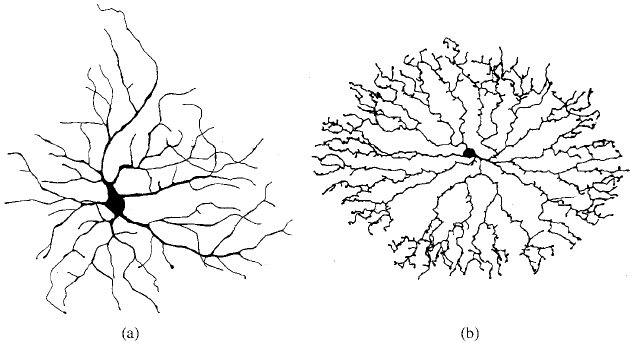
486 14. Use and Abuse of Fractals
Figure 14.1. (a) Typical alpha retinal ganglion cell of the cat: scale bar is 50 µm. (After Freed and Sterling
1988) (b) A typical amacrine cell from the central region of the rabbit retina: scale bar is 100 µm.(After
Tauchi and Masland 1984) Note the different branching structure between (a)and(b).
coverage of isolated retinal ganglion cells using cat retinal cells. They were faced with
qualitatively similar structures to those in Figure 14.1.
Surface and Volume Measurements of Subcellular Membrane Systems at Different
Magnifications. Surface and volume measurements of specific membranes have fre-
quently resulted in widely different values. Such discrepancies in the case of the rat
hepatocyte, for example, were discussed by Paumgartner et al. (1981) who reviewed the
widely different published values for the surface density of reticulum per unit volume
of cytoplasm and the surface density of inner and outer mitochondrial membranes per
unit volume of mitochondrion. The values could differ by more than a factor of three.
Although there are various possible explanations, Paumgartner et al. (1981) concen-
trated on the effect of different magnifications, or scales, at which the measurements
were carried out. To see how such discrepancies can arise we have to appreciate the
basic concepts of fractal topology and look at some simple examples of fractal-type
structures and how to generate them.
Pulmonary Blood Flow. Pulmonary blood flow is an important field and has been
the focus of a major long term study by Robertson, Glenny and their colleagues. Glenny
and Robertson (1990; see also their general review article, 1991a, on applying fractal
analysis to physiology) studied the heterogeneity of pulmonary blood flow using an
analytic fractal procedure which they compared with the traditional gravity model. Im-
portantly they compared their data with their fractal model and obtained a very good fit.
Glenny and Robertson (1991b) compared two branching fractal models, one in which
the branching ratio (that is, the fraction γ and 1 − γ of blood going from the par-
ent to two daughters was fixed and in the other where it could vary about a mean of
0.5) and found that both compared very well with the data. They clearly demonstrated
that, not only does gravitation play a secondary role in producing heterogeneity, but
that fractal models provide a quantitative mechanism for describing structure and func-
14.2 Examples of Fractals and Their Generation 487
tion of the pulmonary vascular tree. Glenny and Robertson (1995) simulated a three-
dimensional branching model for pulmonary perfusion. Spatial and temporal heteroge-
neous pulmonary perfusion is physiologically also important and has been investigated
by Glenny et al. (1995, 1997). With the plethora of articles on the fractal character of
a wide spectrum of phenomena in Nature, many with scant connection to reality far
less experiments, the importance, both pedagogically and scientifically, of the Glenny–
Robertson work on blood perfusion is that their modelling is firmly rooted in reality
and this, plus the fact that it is so closely tied to their experimental work, makes their
physiological conclusions seminal.
Fractal analysis has been applied successfully to a wide variety of natural phe-
nomena and, not withstanding the above criticism, it has proved to be a useful tool.
Cross (1994), after a brief pedagogical exposition of fractals, reviews the use of fractal
geometry in quantitative microscopy. He discusses how it is used in microcomputer-
based image analysis systems and he describes a variety of applications such as certain
bacterial patterns, lung alveoli, tumour edges and others. He also makes a case for its
development in other areas such as screening for carcinoma of the uterine cervix. Part
of the problem with the latter is the difficulty in quantifying the difference between
normal and abnormal cells. There is no doubt that fractal analysis can be an important
tool in this general area although in many instances, it has been overdone and inappro-
priately applied. Panico and Sterling (1995) make a convincing case against the use of
fractal geometry for retinal neurons (see also Murray 1995); we briefly discuss this in
Section 14.4.
14.2 Examples of Fractals and Their Generation
We start by considering a specific fractal called the von Koch curve first described in
1906. As is often the case, this fractal is recursively generated. We start with a line
L
0
and replace the inner third of it with two equal line segments to form L
1
as in
Figure 14.2. Then, with each straight line segment in L
1
do the same again to get L
2
,
then L
3
and so on. The limiting curve L
n
as n →∞is the fractal known as the von
Koch curve. Such recursive procedures can generate curves and structures with some
interesting properties. Denoting the lengths of L
1
, L
2
,... by s
0
, s
1
,... we see that
s
1
= (4/3)s
0
, s
2
= (4/3)
2
s
0
,...,s
n
= (4/3)
n
s
0
,.... That is, the length of each L
increases at each iteration of the rule and the length s
n
→∞as n →∞;inother
words, the limiting curve is of infinite length. Not only that, there is an infinite distance
between any two points on the von Koch curve. From a practical point of view, and in
anticipation of biological applications, such a limit is unobtainable. However, what is
relevant is that the length of the curves depends on the scale we are able to measure
them. We discuss this in more detail below.
There is an obvious self-symmetry between subunits at one generating stage and
the whole structure at a previous one, or even just a part of it. This is clear if we isolate
some specimen sections and compare them with earlier L
n
as shown in Figure 14.2.
So, the von Koch curve, K , is self-similar and it has structure at however small a scale
we look at it. The self-similarity of subunits of the pattern at ever smaller scales is a
particularly common property of certain fractals. In fact, a figure which exhibits this
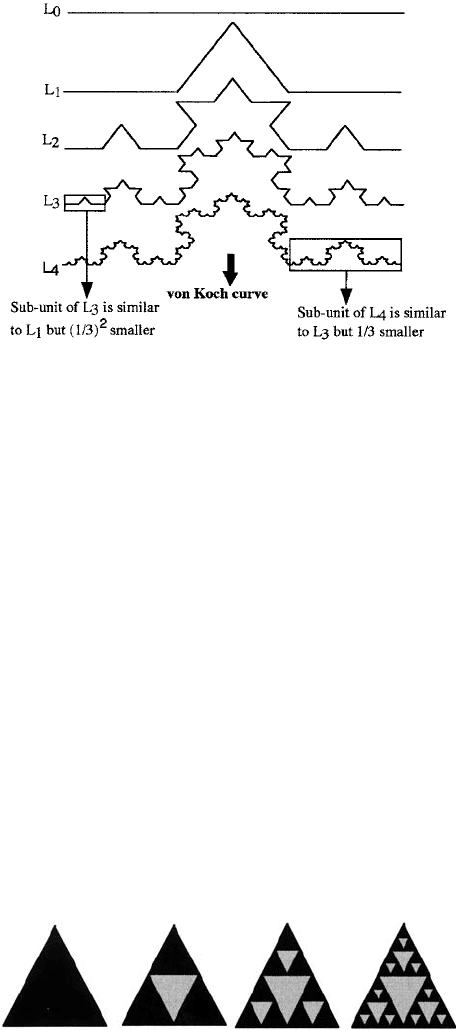
488 14. Use and Abuse of Fractals
Figure 14.2. Construction of the von Koch curve. Here we divide the initial line L
0
into three equal segments
and replace the middle one with two equal lines as in L
1
. We then take each of the segments in L
1
and replace
the middle third with two equal lines to get L
2
. Doing this an infinite number of times results in the von Koch
curve. The length, s, of each line, L,is4/3 longer than the previous one from which it was derived.
self-similarity at ever smaller scales is a fractal although all fractals do not necessarily
have this property; see Figure 14.3.
Let the unit of scale at any generation stage n be µ
n
. Then, if we take the length of
the line L
0
to be unity then µ
0
= 1,µ
1
= 1/3,µ
2
= (1/3)
2
,...,µ
n
= (1/3)
n
and so
on. We can relate the unit of scale, µ, and the magnification, M say, in a simple way. If
we consider the structural subunit enclosed in the box in L
4
andmagnifyitby3weget
L
3
, while if we magnify the structural unit in the box in L
3
by 3
2
we get L
1
: scale µ
and the magnification M are related by µ ∝ λ/M where λ is related to the resolvable
scale unit at magnification unity. By this we mean that if we are looking at a magnified
micrograph it is the unit in the image plane reflecting the test system under investigation
at the smallest magnification. The von Koch fractal curve involves the magnification, M,
which, from a biological application point of view, is not possible; we come back to this
point below since it relates to how we calculate the ‘dimension’ of a fractal.
Another classical self-similar fractal is the Sierpinski triangle first described in
1916. Here you start with an isosceles triangle and repeatedly remove similar trian-
gles a quarter of the area. The initial stages are shown in Figure 14.3. As before we can
calculate the unit of scale (an area here) at any stage. This fractal, as with the von Koch
Figure 14.3. Sierpinski triangle fractal. The construction algorithm is to start with a triangle, remove the
small inner triangle as in the second figure of four equal triangles and continue in this way with each remaining
black triangle but, on a successively reduced scale.
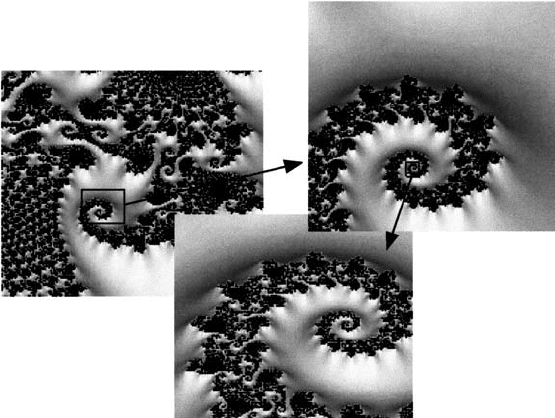
14.2 Examples of Fractals and Their Generation 489
Figure 14.4. Example of a Julia set which exhibits fractal properties. The fractal generator is nonlinear. Note
the similarity of the two successively enlarged parts. It is also possible to see in the third figure how the whole
process continues, although without exact self-symmetry.
curve, can also be used to generate a variety of other fractal curves by using variations in
the rules (see, for example, Peitgen et al. 1992). The existence of self-similar structure
at any scale, however small, is clear.
We can now see how to construct self-similar fractals of whatever complexity you
want. Self-similar fractals, however, are only one small class of fractal shapes. They in-
volve linear scaling laws, which we discuss in more detail below. We can now see how
one could, with a little ingenuity, devise specific fractal generators to produce a vast
variety of shapes which can be tuned to look like all kinds of growing things such as
trees, weeds, starfish, flowers, ferns, snowflakes, cauliflowers and ganglion cells. If we
have nonlinearity in the fractal generators as well, the complex figures we can generate
are unlimited. One example of such nonlinear fractals is Julia sets, after Gaston Julia,
who published his highly original and seminal study in 1918 when he was 25 years old.
They are just one class of nonlinear fractals but possibly the best known since the re-
sulting patterns can be very subtle and beautiful and the dramatic evolution of them can
be easily displayed on a very basic personal computer with simple programmes. These
sets involve transformations in the complex plane; see, for example, the discussion and
numerous examples in the book by Peitgen et al. (1992).
The Julia sets, which are nonlinear and hence not self-similar, are based on itera-
tions of polynomials like z
2
+k, z
2
+z +k, z
3
+k and so on, where z and k are complex
numbers: you can think of a complex number, z, as a pair of real numbers which deter-
mine a point in the plane. The generation algorithm involves repeated applications of
the polynomial transformation. That is, you start with a given z and then evaluate the
effect of the polynomial transformation. For example, start with the point z
0
and evalu-
490 14. Use and Abuse of Fractals
ate the point, z
1
= z
2
0
+k,thenz
2
= z
2
1
+k and so on. The sequence of points is a Julia
set; Figure 14.4 is one computer-generated example. The study of these is interesting
but it should be kept in mind that their connection with real biological applications is
still moot. Later we briefly discuss the relevance of fractals to biological situations in
general.
At this stage we should reiterate the comment about realism concerning many of
these complex figures and algorithmic generation processes which are able to produce
structures so visually reminiscent of those found in Nature. For example, different gen-
erating rules, whether or not they are closely related, can produce the general visual
shape of two different species of trees. Although this is interesting it says very little
about the actual biological pattern formation mechanisms which generate the structure
and, without considerably more biological input, as explanations of how the tree grows
and is formed is possibly of little more value than an artist’s impression. I do not mean
to imply that fractals are of little use in biology, only that invoking fractal theory in the
study of genuine biological situations has to be done with considerable care and, above
all, biological realism.
14.3 Fractal Dimension: Concepts and Methods of Calculation
The dimension of traditional geometric shapes is very clear. A line is one-dimensional,
a figure in the plane is two-dimensional and what constitutes a three-dimensional shape
is obvious. The dimension is the minimum number of coordinates needed to specify
a point on the figure. For example, on a given curve we can specify any point by a
single coordinate, namely, the arc length from a given point on the curve and so it
is a one-dimensional figure. A point on a plane needs two coordinates so it is two-
dimensional and so on. Do the von Koch fractal, the Sierpinski triangle and the ganglion
cells in Figure 14.1 have a dimension? Certainly the first two do not conform with our
normal concept of dimension and so we have to extend our ideas as to what we mean
by ‘dimension’ and specifically by the ‘fractal dimension.’
The von Koch curve is a fractal which has the unusual property that there is an
infinite distance between any two points on the curve. The curves which generate the
von Koch curve are also clearly fractal since any small subunit is just a reduced ver-
sion of part or the whole of one of the curves above it. What is the dimension of the
curve? Since it is a curve it might be thought that it is one-dimensional. However, since
the distance between any two points on the curve is infinite we cannot get from one
point on the curve to another by specifying the distance since all points are infinitely
far away from each other. It is clearly not two-dimensional since it does not have any
‘area’ so perhaps it has a dimension between 1 and 2, but how do we define it and
calculate it?
Although this might seem like academic sophistry it has a genuine practical rele-
vance to the problem studied by Paumgartner et al. (1981) mentioned in Section 14.1.
Let us consider a curve such as in Figure 14.5(a) and suppose it represents part of
the boundary of some biological membrane of which we want to know the length. If
we measure the curve with a ruler that has a scale, r
1
say, as in Figure 14.5(b) we
cannot detect the various indentations between the end points of the ruler. We get the
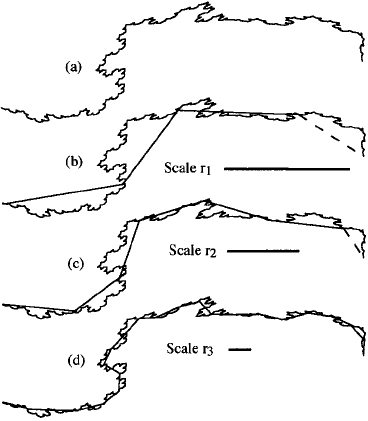
14.3 Fractal Dimension: Concepts and Methods of Calculation 491
Figure 14.5. The effect on the measured
‘length’ of the curve in (a)aswevarythe
scale on which we measure it. The ‘length’
of the curve measured with a large unit of
scale, r (that is, small magnification) as in
(b), is smaller than the ‘length’ measured
with the scales in (c),whichinturnis
smaller than that with the scale in (d).
length as the number of units needed to cover the curve. If we use a smaller scale, as
in Figure 14.5(c), we get a different answer since we can now account for some of the
finer indentations. So, as we reduce the scale, or in other words, as we increase the
magnification, we get an increasing value for the ‘length’. We would really like to be
able to use a scale that is smaller than any of the small indentations in the curve so
that we could get an accurate value for the length. But suppose the magnification re-
quired for such a scale cannot be achieved; how do we determine the true length? To
get some idea of how to do this we consider in more detail fractal-generating scaling
laws.
Dimension of a Self-Similar Fractal and Scaling Laws
Consider a square of side S. If we scale down each side by a scale factor r = 1/2then
we need 4(= 2
2
) of the smaller boxes to fill the original square. If we scaled-down
by a factor r = 1/3 we need 3
2
of the scaled-down squares to fill the original square.
Generally if we scale down by a factor, r, we need (1/r)
2
reduced squares to fill the
original square. If we do the same with a cube then, with a scale factor r, the number of
cubes needed to fill the original box is (1/r)
3
. The power of 1/r is directly related to
the geometric dimension of the original figure, 2 for the square and 3 for the cube. If r is
the scale factor and m(r), which is a function of r, denotes the number of scaled-down
pieces (similar to the original figure) which are needed to fill the original figure then for
the square and the cube m = (1/r)
D
,whereD is the dimension, 2 for the square and 3

492 14. Use and Abuse of Fractals
for the cube. This suggests a reasonable definition of the dimension, D, of a self-similar
fractal, such as we derived above is given by
m =
1
r
D
⇒ D =
ln m(r)
ln(1/r)
(14.1)
on taking the logarithm of both sides. Strictly the fractal dimension, D
fractal
,isgivenby
the limit of this expression as the scale factor r →∞; that is, the actual unit of length
scale tends to zero, and so
D
fractal
= lim
r→∞
ln m(r)
ln(1/r)
. (14.2)
In the case of the von Koch curve the successive generations of the curves L
k
,for
any k, with length s
k
, are made up of four equal pieces each of which is similar to
the previous curve L
k
− 1, with length s
k
− 1, but scaled down by a factor of three.
So, here the number of copies m = 4 and the scale factor r = 1/3. With the fractal
definition of D in (14.2) we get the fractal dimension of the von Koch curve to be
D = ln 4/ ln 3 = 1.262, which is indeed between 1 and 2.
Let us now consider a general scaling law and some quantity, Q say, which depends
on the scale, r, at which we measure it. As an example, and to be specific, if we refer to
Figure 14.5 we can see that the finer the scale the more detail can be accounted for and,
as a consequence, the measured length increases the finer the scale, r, that is, the larger
the magnification, we use. So, Q(r) is a function of r and if we think of the length of
the curve in Figure 14.5, Q = N(r)r,whereN(r) is the number of scale units needed
to cover the curve at scale r.
If a figure is self-similar we can say something about the behaviour of N(r) as a
function of r. Recall the discussion above with the square and cube and their subdivision
into smaller squares and cubes. With the square when the scale factor was r = 1/2we
needed N (r) = (1/r)
2
of the smaller units to fill the original square. With the cube it
was N (r) = (1/r)
3
of the smaller subunits. The powers of 1/r directly relate to the
dimension of the quantity considered. So, in general for a self-similar scale law we have
N(r) =
C
r
D
, (14.3)
where C is some constant and D is the dimension which characterises the quantity, Q.
In the square and cube examples if we start with a known area and volume, C is that area
and volume respectively. When dealing with a quantity we do not know, C is unknown
a priori. With the expression for N(r) in (14.3) we have
Q(r) = N(r)r =
C
r
D−1
. (14.4)
Taking the logarithm of both sides gives

14.3 Fractal Dimension: Concepts and Methods of Calculation 493
ln Q(r) =−(D − 1) ln r + ln C. (14.5)
From a practical point of view, we plot ln Q(r) against lnr for various r and the gradient
then determines the fractal dimension D.
The definition of the dimension in (14.4) is consistent with that given in (14.1). To
see this, replace Q(r) in (14.5) with the expression from (14.4) to get
ln N(r)r =−D ln r +ln r +ln C
⇒ D =
ln N(r)
ln(1/r)
+
ln C
ln(1/r)
≈
ln N(r)
ln(1/r)
for r small. (14.6)
This is the same as the definition of the dimension D defined in (14.1) since N(r) =
m(r). We should remember that it is magnification, M, which is used in experimental
measurements rather than the unit of scale, r. There is a direct proportionality between
M and r, namely, M = µ/r where µ is some proportionality factor which can be
calculated. In terms of the magnification, M, the dimension D is then given by (14.5)
which becomes
ln Q(M) =−(D − 1) ln(1/M) + ln[µ
−(D−1)
C]. (14.7)
The last term in (14.7) is simply a constant and not important at this stage; we
briefly talk about it later. If the quantity Q is fractal then the expression in (14.6) is a
straight line in the log–log graph. Use of experimental measurements at different scales
can suggest whether or not a biological quantity is fractal—or approximately so. A spe-
cific experimental example is the electron micrograph measurements by Paumgartner
et al. (1981) of the inner and outer mitochondrial membranes and endoplasmic retic-
ulum briefly mentioned above. Here Q represents length and surface measurements.
They plotted the logarithm of the various measurements, Q, against the logarithm of
1/M,whereM is the magnification; the results shown in Figure 14.6 are based on those
presented in their paper.
Referring to the data points on Figure 14.6, for magnifications greater than 130,000
we see that in that region the fractal density D = 1. In other words there is no finer
structure beyond this magnification and so we are seeing the whole structure with no
‘hidden’ complexities. We know that in a strictly, or theoretical, fractal situation such
as with the von Koch curve, the limiting length is infinitely large. In any biological
situation it is not possible to continually increase the magnification indefinitely. In fact
there is a definite limit to the scale, r, at which stage the dimension becomes the usual
topological dimension. In Figure 14.6 the dimension is D = 1 for magnifications larger
than 130,000 which determines (approximately) the physical limit.
It is appropriate at this stage to ask what the use is in showing that something is
fractal. In many situations the answer is that it is of little use. In others, however, it
can be informative. Let us suppose that we can only measure Q, which in Figure 14.6
are lengths and surfaces, for only a small range of different scales and not as far as
the limiting one, r
limit
, which corresponds to a 130,000 magnification beyond which
the structure has an integer dimension. Let us further suppose that the measurements
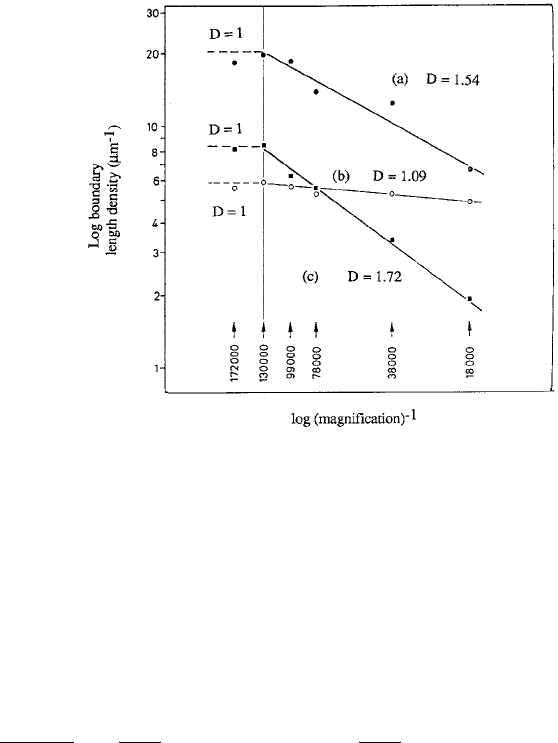
494 14. Use and Abuse of Fractals
Figure 14.6. Boundary and surface measurements of specific liver cell membranes of the rat as a function
of the magnification M:(a) inner mitochondrial membrane, (b) outer mitochondrial membrane and (c)en-
doplasmic reticulum. Note the straight line nature of the curve for magnifications in the range ×18,000 <
M < ×130,000. (Redrawn from Paumgartner et al. 1981) The straight line portion implies an approximate
fractal behaviour with the fractal dimension, D, determined from fitting (14.7) to the data points. Note that
for magnifications greater than 130,000 the graphs imply D = 1.
are sufficient to demonstrate fractal behaviour and an approximate fractal dimension D.
Then from (14.4) the ratio of the measures of Q at scale r and at scale r
limit
is given by
Q(r
limit
)
Q(r)
=
r
r
limit
D−1
⇒ Q(r
limit
) =
r
r
limit
D−1
Q(r) = K
c
Q(r), (14.8)
where K
c
is the correction factor to the measurement at scale r. This presumes a knowl-
edge of the physical limiting scale r limit. One of the practical uses of finding fractal
behaviour, such as in this biological example, is that it clearly shows how important the
scale can be in measuring the specific quantities and that conclusions based on observa-
tions at larger scales can be inaccurate.
Another important potential use for more accurate spatial measurement, specifi-
cally surface area, is associated with quantifying diffusion fluxes of chemicals through
such a membrane surface. The amount of a chemical which diffuses through a surface
is directly proportional to the surface area. So, if a surface is fractal, or quasi-fractal,
we can obtain a more accurate approximation to that flux if we know the fractal di-
mension. Of course, the fractal ‘indentations’ must not be so fine that the random walk
approximation to diffusion is no longer valid but in practice this is generally not the
case.

14.3 Fractal Dimension: Concepts and Methods of Calculation 495
Non Self-Similar Fractals and the Box-Counting Dimension
If a fractal is not self-similar we have to generalise our concept of a fractal dimension.
We also have to have some method for calculating it in any experimental situation. An
example of a fractal which is not self-similar is shown in Figure 14.3. One method
which is widely used is called box counting and which we now describe. There are
others some of which are discussed in the books cited above. Basically all the methods
rely on measurements of some quantity at different scales, r, or magnifications, M,in
the above notation. Effectively the measurement at a given scale ignores irregularities
at a smaller scale.
The box method involves covering the object of measurement with regular square
boxes (circles or spheres are also used) of size r; refer to Figure 14.7. If the measure-
ments are in the plane then squares are used while cubes are used if the body measure-
ments are three-dimensional. In Figure 14.7(a) let us suppose the original smooth curve
has length L. Then the number of boxes N(r) is related to the size of the box used
which depends on the unit of scale r;hereN(r) ∝ L/r. If it is a region, with area A,as
in Figure 14.7(c), then the number of boxes N(r) ∝ A/r
2
. In the case of a power law
(14.3), N(r) ∝ L/r
D
and the fractal box dimension is, from (14.6), then given as
D = lim
r→0
ln N(r)
ln(1/r)
(14.9)
as long as the limit exists.
If we now return to the cellular structures in Figure 14.1 we can calculate the box
dimension by covering the cell with a network of square boxes of given size (scale)
which specifies r, and simply counting them to get N(r). Then, progressively decrease
Figure 14.7. Box-covering methods for a line as in (a)and(b)oranareaasin(c). A part of the curve or area
must lie in each box. In the case of the line in (a) it is possible to have a different box covering as shown in
(b). In the limit of very small scale boxes the number needed to cover the line is approximately the same.
